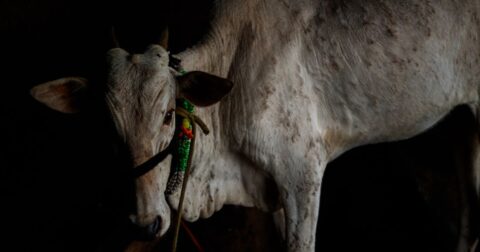Solutions
Shareholder Activists Push Fast Food Chains to Commit to Climate Targets
Climate•4 min read
Reported
Even as a painful and lethal disease wipes out millions of cows and buffalo, India's dairy industry keeps pumping out more milk.


Words by Sanket Jain
Subhash Gaikwad opened the viral WhatsApp video and felt terrified at what he saw. Several cows in India’s Rajasthan state lay dead on the ground, covered with red lesions across their bodies. “I always prayed that this disease shouldn’t reach our village,” the 36-year-old farmer says.
By disease, Gaikwad means Lumpy Skin Disease. This most recent outbreak has infected over 3.2 million cattle in India during a 10-month period, killing an average of around 600 cows and buffalo per day. Despite the losses and massive climate pollution caused by the sector, the dairy industry is poised to pump out even more milk this year. U.S. Department of Agriculture researchers predict India’s dairy sector will produce 207 million metric tons of milk, yogurt, ghee and the like this year.

Lumpy Skin Disease, or LSD, is a highly contagious virus. It afflicts cows and can be spread by blood-feeding insects, like ticks, mosquitoes and flies. In cattle, tell-tale symptoms include skin lesions and a high fever. Farm animals soon lose their appetite, and can experience swollen limbs and genitals.
Within just two months, the disease did reach Gaikwad’s farm in the village of Jambhali in India’s Maharashtra state. His Jersey cow first stopped eating, and then her legs began to swell. Within two days, her fever topped 107 degrees Fahrenheit, and the nodules spread across her body. Her lungs were damaged, and soon she was left gasping for breath. From far away, people could hear the cow cry out, says Gaikwad’s 65-year-old mother, Parvati. The entire family was heartbroken.
Gaikwad visited a new doctor every morning, hoping he could find at least one who could help save the cow. He tried countless remedies and treatments. “I even applied turmeric mixed with karanja oil,” he says, referring to a cold-pressed oil extracted from the seeds of the pongam tree. At one point, she was so covered in the oil that “the cow was shining in yellow,” he says. But none of it helped, and after a month of treatments and over 20,000 rupees, his cow, the cow whom the family fondly called Gouri died. “We couldn’t even look at her. It was so painful,” he says, teary-eyed.
This latest disease outbreak is just one of the many challenges facing the Indian dairy sector in a rapidly warming climate. Last summer was one of the hottest on record in India, with more than 90 percent of the country predicted to become vulnerable to extreme heat danger zones in the near future, according to University of Cambridge researchers. Along with heat waves, the country is also experiencing more flooding, and more cows suffering and dying from climate-related heat stress as feed crops are routinely drowned or damaged during bouts of extreme weather.

Yet dairy farming isn’t just at risk from climate change, it’s also one of the leading drivers of climate pollution. While not quite as emissions intensive as beef, dairy production contributes methane emissions from cattle burps and manure, as well as land use from grazing cattle. Emissions from meat and dairy farming have steadily increased in the past several decades, both across the globe and in India. Worldwide, emissions from dairy farming increased by 18 percent between 2005 and 2015, according to FAO research, and emissions from meat and dairy combined now make up around 14 percent of all global greenhouse emissions — as much as 19 percent by some estimates.
India is now the largest global producer of dairy, with production more than doubling during the first two decades of this century. Imports and exports have also ticked up in the past year. According to the Hindustan Times, milk imports surged by over 1000 percent to $4.77 billion between 2022 and 2023, as Lumpy Skin Disease decimated hundreds of thousands of dairy cows and retail prices spiked. Meanwhile, exports of ghee ticked up as global demand for butterfats soared. Government minister Amit Shah encouraged the trend, telling a room of dairy industry professionals in March that India should aim to be one of the world’s leading dairy exporters.
Yet India already doesn’t have enough public veterinarians to treat livestock during a disease outbreak. Though there are 535.78 million farmed animals in India, there are only a little more than 73 thousand registered veterinary practitioners, which works out to be around one veterinarian for every seven thousand farmed animals.
Climate researchers, like those at the IPCC and the World Resources Institute, continue to urge a broader dietary shift to more plant-rich proteins, especially in the global north, where residents have long overconsumed animal-derived foods like beef. Yet with few exceptions like Germany, global consumption is headed in the wrong direction, with dairy intake predicted to rise over this decade, despite the massive toll on the planet.
In India, there are alternatives to animal-derived dairy, but it’s still early days and the plant-based market has a long way to go. The field is a fraction of the size of the massive dairy sector — worth $140 billion in India, while the market for plant-based milk stands at just $25 million. The sector might reach $63.9 million by 2024 according to the Good Food Institute in India and, though dietary shifts can be complicated, perhaps more if prices can come down and alternatives can win out for dietary staples like ghee and yogurt.
all photos by Sanket Jain